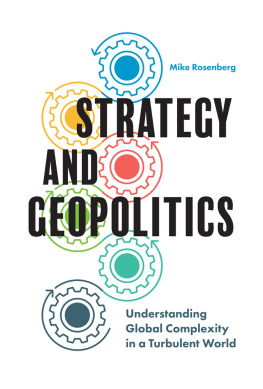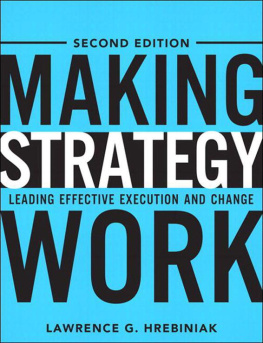Decision-Making for Value Creation
BUSINESS
LEADERSHIP
IN TURBULENT TIMES
MICHAEL LAWRIE AND
GEORGE TSETSEKOS

Copyright 2021 Michael Lawrie and George Tsetsekos.
All rights reserved. No part of this book may be used or reproduced by any means,
graphic, electronic, or mechanical, including photocopying, recording, taping or by
any information storage retrieval system without the written permission of the author
except in the case of brief quotations embodied in critical articles and reviews.
This book is a work of non-fiction. Unless otherwise noted, the author and the publisher
make no explicit guarantees as to the accuracy of the information contained in this book
and in some cases, names of people and places have been altered to protect their privacy.
Archway Publishing
1663 Liberty Drive
Bloomington, IN 47403
www.archwaypublishing.com
844-669-3957
Because of the dynamic nature of the Internet, any web addresses or links contained in
this book may have changed since publication and may no longer be valid. The views
expressed in this work are solely those of the author and do not necessarily reflect the
views of the publisher, and the publisher hereby disclaims any responsibility for them.
Any people depicted in stock imagery provided by Getty Images are models,
and such images are being used for illustrative purposes only.
Certain stock imagery Getty Images.
ISBN: 978-1-6657-0878-4 (sc)
ISBN: 978-1-6657-0877-7 (hc)
ISBN: 978-1-6657-0876-0 (e)
Library of Congress Control Number: 2021913065
Archway Publishing rev. date: 09/15/2021
ACKNOWLEDGMENTS
T his book benefited from numerous discussions with fellow executives and many leaders who shared views and constructive suggestions in creating corporate value and navigating change during crises. Our interactions with academics provided insights from plethora of research findings on strategy, culture, and finance and offered the intellectual foundation for developing a unified theme, bringing together theory and practice for business leadership. We are grateful to our colleagues for their support and often criticisms for shaping our experiences in leadership roles in business and academia. We are especially thankful to many Drexel University business students who attended the Lawrie Leadership Development program and the LeBow MBA program at Vanguard; discussions and debates provided comments on the pedagogy and refined our methodology for decision making. We also express our gratitude to several speakers who shared their deep professional knowledge and subject matter expertise during our lectures and presentations. While not an exhaustive list, we are grateful to Alyse Bodine, partner at Heidrick & Struggles, Will Forrest, Senior Partner at McKinsey, Ed Nelling, Professor of Finance and Head of the Finance Department at Drexel, Krishnan Rajagopalan, President & CEO at Heidrick & Struggles, Jo Mason, former Chief HR Officer at DXC, Dave Kurz, Professor of Business at Drexel University, Jo Gupta, Partner at McKinsey, Joseph May, Managing Partner Adelphi Capital Partners, Paul Saleh, President & CEO of Gainwell Technologies, Dustin Semach, CFO of Rackspace Inc., Jonathan Ziegert, Professor of Management at Drexel University, and Pallav Jain, Senior Partner at McKinsey, for sharing with our students their experiences. Special thanks to Teresa Harrison, Professor and Associate Dean of the LeBow College of Business for reviewing early parts of the manuscript, and introducing innovations in delivering our lectures and presentations to Drexels MBA students. John Papadopoulos, Justin Luu and Jeanne Ruane offered fantastic research support during earlier drafts of the book. We recognize Linda Pancari and Angel Hogan for their assistance in managing our demanding schedules and often reminding us of important deadlines. Finally, we appreciate the tolerance of our families for taking precious quality time away from them while being involved in countless hours of zoom conversations and absorbed in writing the manuscript.
CONTENTS
Theory and Practice:
Polarities and Contradictions
T his book is intended to help leaders navigate the differences, the polarities, and sometimes the contradictions between the theory of how things are done and the practicality of what must be done, the what and the how. When you are leading an organization, it is important to have a theory and a framework to guide your thoughts about issues and challenges. Based on simplifications and abstractions from reality, the theory provides a foundation for the development of a rational hypothesis, which invariably leads to solutions and gives a sense of how things should be done.
In this regard, having a good generalizable theory to confront business management and strategic challenges helps leaders frame problems and make decisions. However, a theory can never consume the ability to respond, act based on the situation, and adapt to your environment. It is the unique circumstances that make leaders deviate from a theory to present practical solutions. Indeed, while a theory offers a general approach to solving problems, every situation is unique. Applying only theory may lead to misguided answers. Relying exclusively on the world of practice weighs heavily on uniqueness and exceptional or perhaps extreme circumstances. In short, one must always hold two contradictory thoughts in mind while leading and should reconcile both thoughts in a rational way. There are times when the theory provides clarity and guides decision-making to a path of certainty and success. There are other times when practicality forces you to deviate from a straightforward path or to confront unexpected issues and circumstances that will eventually let you complete the work successfully.
Therefore, business leadership and strategy are all about holding two seemingly contradictory views. A metaphor for strategy is the behaviors of the hedgehog and the fox. The hedgehog has a comfortable routine and follows a determined path well-planned ahead, methodically with precision. The behavior of the fox is different. By developing quick thinking with increased awareness and great adoptability when faced with tricky and difficult situations, the fox is responsive and finds ways out of tricky circumstances. Business leadership and strategy are not fully based on the behaviors of these two animals. It is not a straightforward plan (that is, the behavior of the hedgehog) that moves in a methodical way toward a goal where the leader stays absolutely focused, straight ahead. Nor does it reflect the behavior of a fox because while the fox has set on a well-thought-out plan, it capitalizes on unexpected opportunities by changing the course of action. A strategy reflects the balance between these two allegories of behavior. On one hand, insights, intuition, analysis, and the process and then the ability to make the strategy work require the ability to maneuver the strategy itself. Business leadership and strategy are therefore not a linear process but a very dynamic, complex, and chaotic process.
The purpose of this book is to provide a framework and a methodology to support leaders in balancing these opposing forces and contradictions as they move forward. We advance the notion that business success leading to value creation is based on five fundamental drivers: (1) strategy formulation, (2) asset deployment, (3) a financial model that supports the strategy while it creates profits, (4) leadership of the CEO and its team, and (5) organizational culture. While these drivers, components, or elements of our framework independently are well understood as key components to a plan, their management is paramount for value creation. All these elements are interdependent; however, they should be considered in an integrated way. Conventional wisdom and theory suggest that strategy is the only element that defines the success of a business. We believe the contradiction is that, in practice, strategy is an important facet but not the only determinant for success. While strategy provides a road map, it remains an aspirational plan unless it is supported by strong leadership, a robust asset-deployment program, a financial model that aligns investments with profits, and an inspiring culture with the support of teams allowed to execute the strategy. All these considerations taken together represent concepts that deliver a powerful perspective and offer an implementable framework for managing a company. It is a paradigm based on the idea that two possible contradictory views, the theory, and the practice, can provide answers to adapt to unique circumstances. While it is intuitive to think about the paradigm for companies with cash flows and profitability, the paradigm is equally applicable for nonprofits, where key drivers, such as assets, a financial model, leadership, and culture, are present.
Next page









